How to successfully hire remote employees
Remote work is here to stay. Everything you need to know about hiring remote workers from designing a successful interview to keeping track of incoming applications.
For many managers, conducting employee performance reviews is one of the worst parts of the job. Evaluating employee performance can be uncomfortable, tedious, and stressful. Yet, it’s also an important part of managing employees.
One way to make employee performance evaluations more manageable is to use a strong performance review template. A template can help guide you and your employees through the performance review process to ensure you all learn as much from the reviews as possible.
This blog will explore importance and the best practices in conducting performance reviews. Most importantly, you’ll learn more about performance review templates which will help you streamline an effective evaluation process:
Performance reviews are evaluations of what each employee is doing well and what they can improve in their work. They can be formal write-ups based on strict criteria or more informal one-on-one conversations between employees and their managers.
Managers generally conduct regular performance reviews as a way to check in with their employees. Annual performance reviews used to be standard, but now companies often encourage managers to complete performance reviews quarterly or even monthly.
Conducting performance reviews should be about more than just rushing through evaluations and ticking a box. Performance reviews can offer actionable feedback to both your employees and the company. If you don’t regularly evaluate employee performance, your employees will likely struggle to improve.
Performance reviews aren’t just for helping employees grow, however. Apply performance reviews in several different ways as a manager, including:
It’s not enough to just have a mental picture of how well your employees are performing. Conducting regular performance reviews will help put everyone on the same page and provide documentation for decisions like promotions and compensation changes.
When you complete performance reviews, the best-case scenario is that they yield constructive feedback and offer recognition for a job well done. Unfortunately, performance reviews don’t always go so smoothly. To improve your performance review process, try implementing the following tips:
Recognize that performance reviews can be anxiety-inducing for your employees. To reduce their stress, make sure employees know what to expect during the performance review process.
If possible, involve your employees in some of the planning and preparation for review meetings. Share the agenda for the meeting ahead of time, for example, and ask your employees if they’d like to add any topics to the list. No one wants any unnecessary surprises.
Streak can help you track performance review steps for each of your employees. Steak also lets you set reminders for milestones with pipelines in Gmail to keep your employees in the loop. To utilize this feature:
Your employees will appreciate the transparency!
Confrontational meetings in which managers talks at their employees instead of with them won’t accomplish very much. You want your performance review meetings to be two-way conversations rather than lectures. Engage your employees and make sure they feel heard. You’ll both get more out of the meetings that way.
It’s a data-driven world, and the best performance reviews aren’t purely subjective. Managers should use data and examples whenever possible to support their performance evaluations. This information can include input from colleagues or other managers, accomplishments during the evaluation period, and customer satisfaction ratings, when applicable.
Data and examples can help employees trust that performance review results are fair. They also give employees something concrete to refer back to or change going forward.
Traditionally, performance reviews were all about past performance and behavior. Certainly still focus on those things, but don’t forget to look ahead to the future, too. One goal of performance reviews is to drive future performance. Offer feedback your employees can implement going forward and discuss how their work fits into the organization’s broader goals.
You can choose your performance review questions on the fly, but that isn’t likely to yield the best results. A performance review template gives you a framework that walks you and your employees through the evaluation, ensuring you cover everything. Email your employees the performance review template ahead of your official performance review to give them time to process the contents.
Performance reviews are vital for a company as they align employee goals with company objectives, assess performance, and foster growth and communication. Performance review templates streamline the evaluation process, ensuring consistency and clarity in assessing employee performance, aligning goals, and fostering development.
You don't have to reinvent the wheel to complete employee reviews. Applying performance review templates is one way to standardize performance reviews across your department or even the whole company based on evaluations that work. Use the knowledge that other managers and organizational researchers have developed to guide your performance reviews.
Here's why you should consider using a performance review template on your next evaluations:
Managers and business owners can spend so much time establishing a performance review process that they no longer have time to evaluate the results and discuss with their employees. A performance review template helps you save time and energy, so your company can focus on boosting or amending the potential results of the performance review.
Performance review templates offer you a starting point. With the right template, you will optimize your performance review process. In short, less time on preparation and more on implementation!
Regardless of how professional your company members are, your personal rapport with coworkers and direct reports can still influence performance reviews.
While subjectivity provides a sense of humanity in a performance review, there's no denying that it can sometimes make managers and business owners veer away from a evaluation process.
Performance review templates help employers focus on employee performance based on their KPIs. This way, you can get qualitative and quantitative data to help you create a roadmap for your business.
One of the common mistakes among business owners and managers is to see performance reviews as surprise examinations. This can be stressful for the employees, reducing their productivity and efficiency.
Sharing a review template with your employees allows them to assess their performance going into the performance review. They will know if they are fulfilling their roles adequately, hitting their targets, and adhering to company policies. This process boosts the company's sense of self-management. So instead of examining all the bits and pieces of your employee's performance, you will just be polishing their work on your periodic performance review.
However, note that you don't have to reinvent the wheel to complete employee reviews. Using performance review templates is one way to standardize performance reviews, but be sure to also use knowledge that other managers and organizational researchers have developed to guide your performance reviews.
There are a variety of templates available, but we curated six of the top performance review template samples for you.
Command+click on a Mac, Ctrl+click on a PC, or right click to download any of the templates for your own use.
<div class="anchor-wrapper"><div id="classic-employee-evaluation" class="anchor-target"></div></div>
If you don’t want to mess with the traditional employee evaluation, try this classic performance review template. It asks managers to rate how often employees hit key performance indicators like how often they submit assignments on time and show initiative.
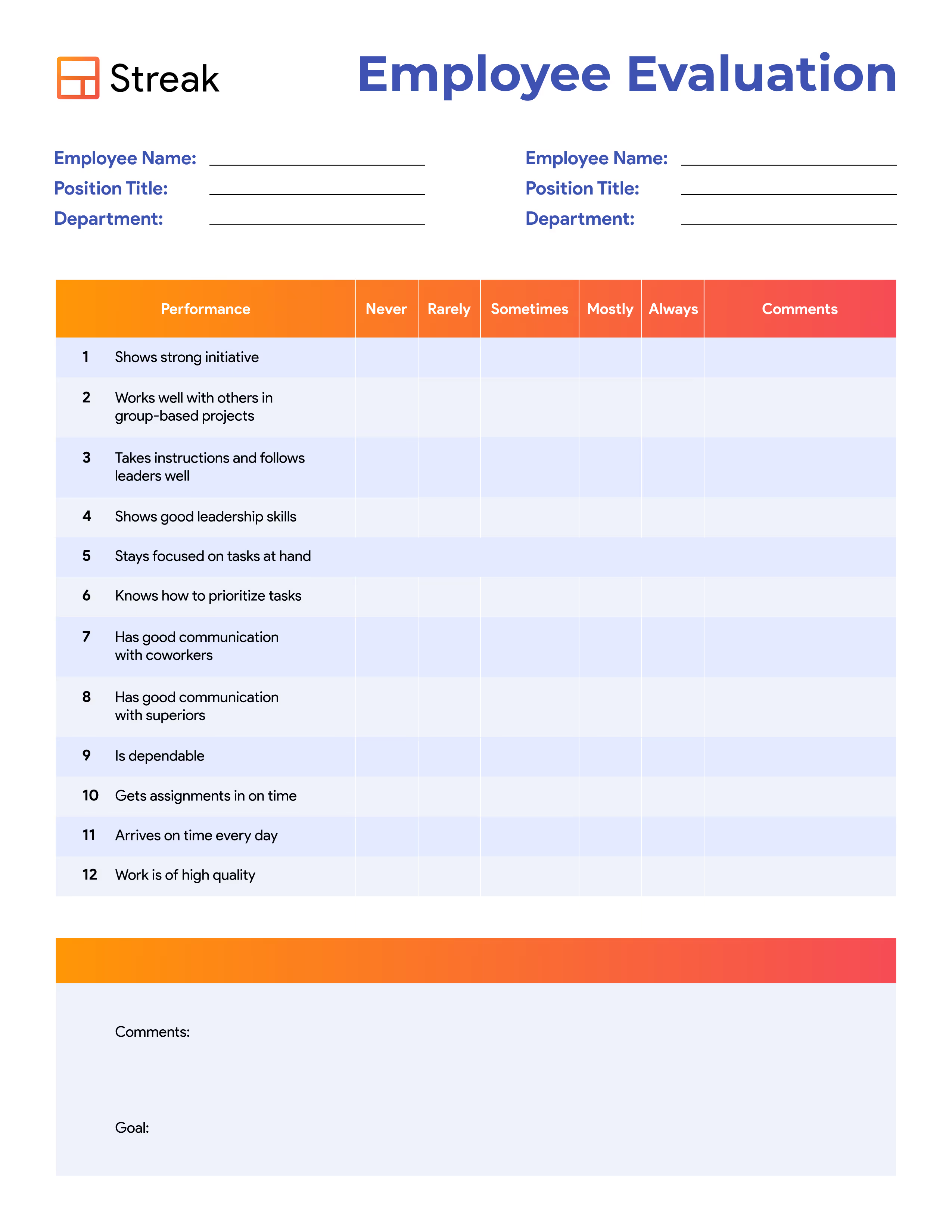
<div class="anchor-wrapper"><div id="streaks-self-evaluation" class="anchor-target"></div></div>
Streak’s Self-Evaluation Performance Review Template is for employees to fill out themselves. It asks them to review their own progress and weaknesses as well as complete a peer review and a review of their manager/company. The manager then reviews this self-evaluation and adds their own opinions afterward.
The idea behind including self-evaluation in performance reviews is that employees can often offer a different perspective to their managers. It gives employees the opportunity to reflect and take responsibility for their performance while also leaving room for the manager’s input.
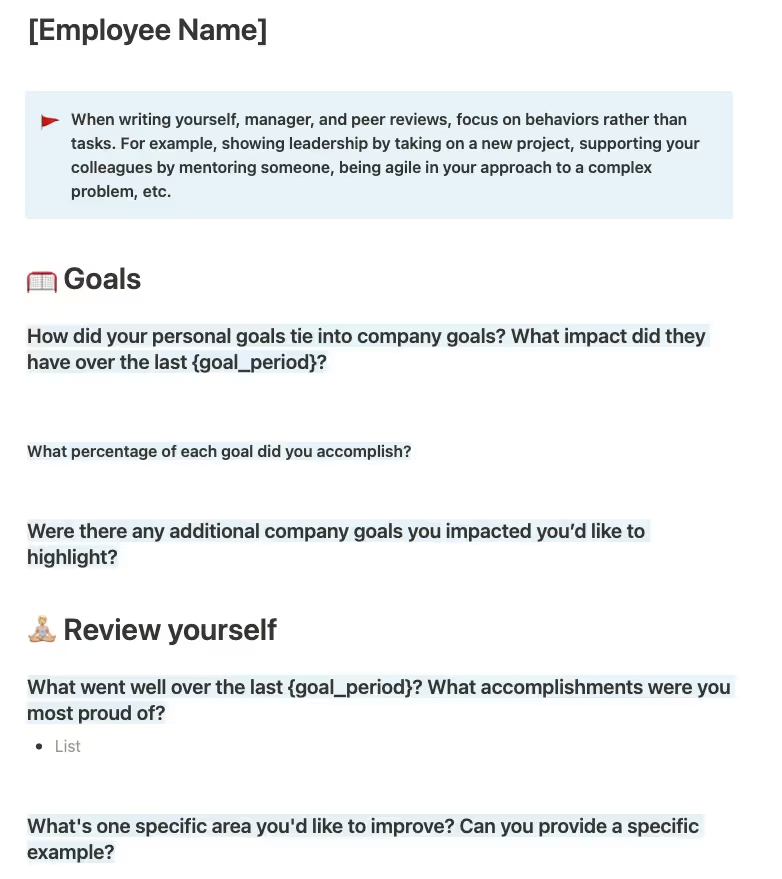
<div class="anchor-wrapper"><div id="good-performance-review" class="anchor-target"></div></div>
G.O.O.D is an acronym for goals, obstacles, opportunities, and decisions — the four areas this performance review template highlights. It’s more of a conversation guide than a form. G.O.O.D. encourages managers to ask specific questions that address how each employee has performed in these areas.
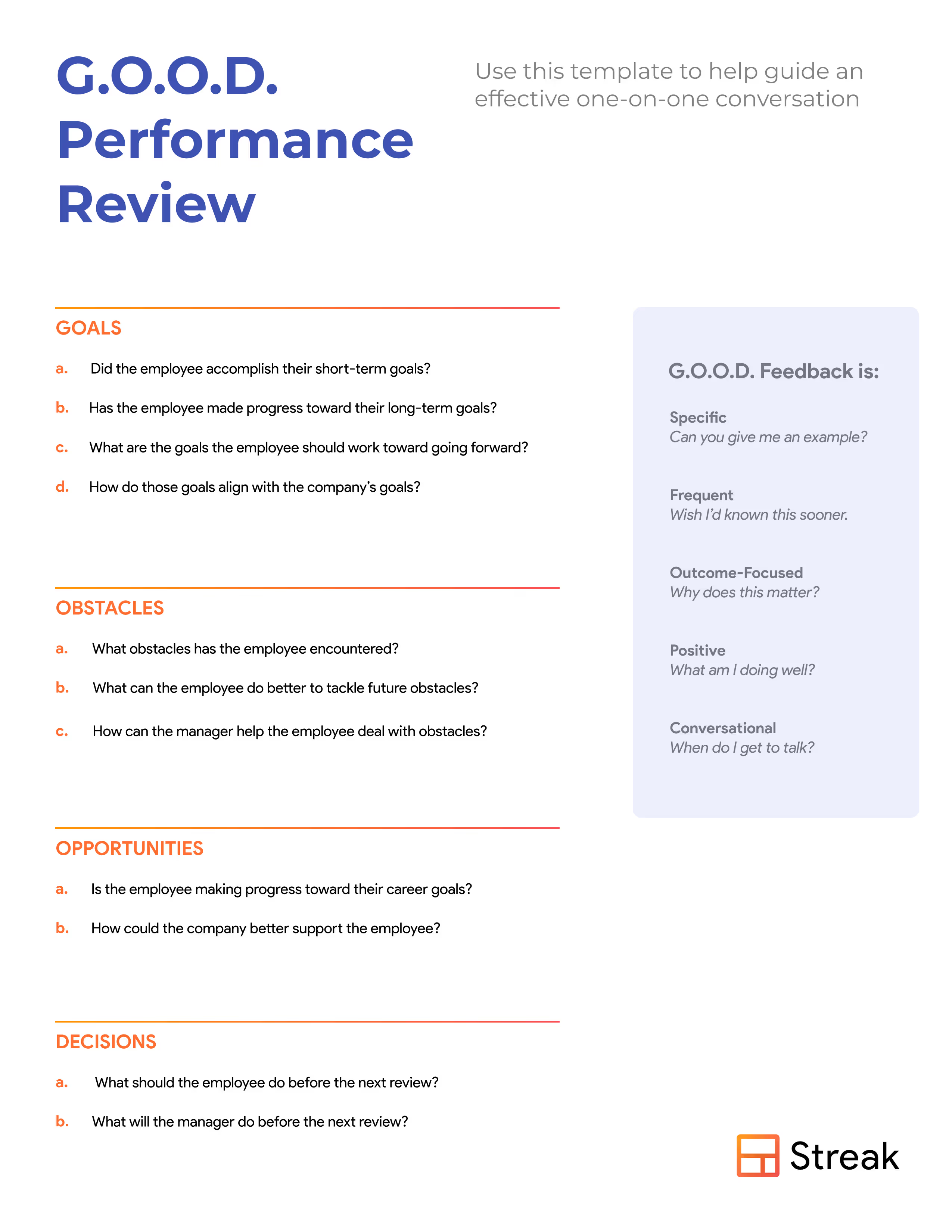
<div class="anchor-wrapper"><div id="30-60-90-performance-evaluation" class="anchor-target"></div></div>
30-60-90 performance evaluations are meant to offer frequent check-ins between new hires and their managers when they start their new positions. Employees and managers complete these evaluations after the employee has worked at the company for 30 days, then again at 60 days, and one more time at 90 days.
These can also be used for employees on Performance Improvement Plans (PIP) to see how they're improving over the course of the PIP.
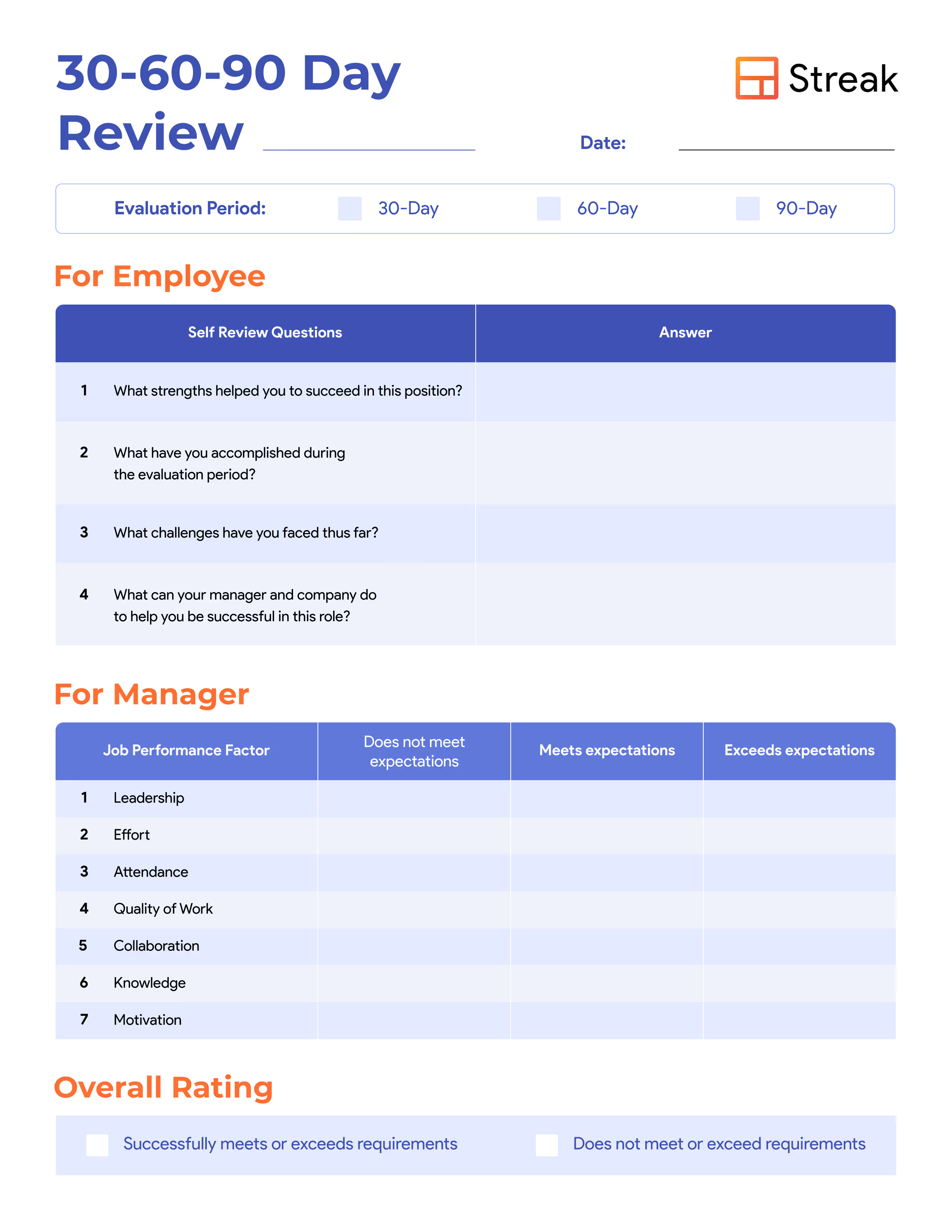
<div class="anchor-wrapper"><div id="quarterly-performance-check-in" class="anchor-target"></div></div>
Many companies don't perform quarterly performance reviews, but if you want to frequently check in with employees about their progress, this template will help you do it.
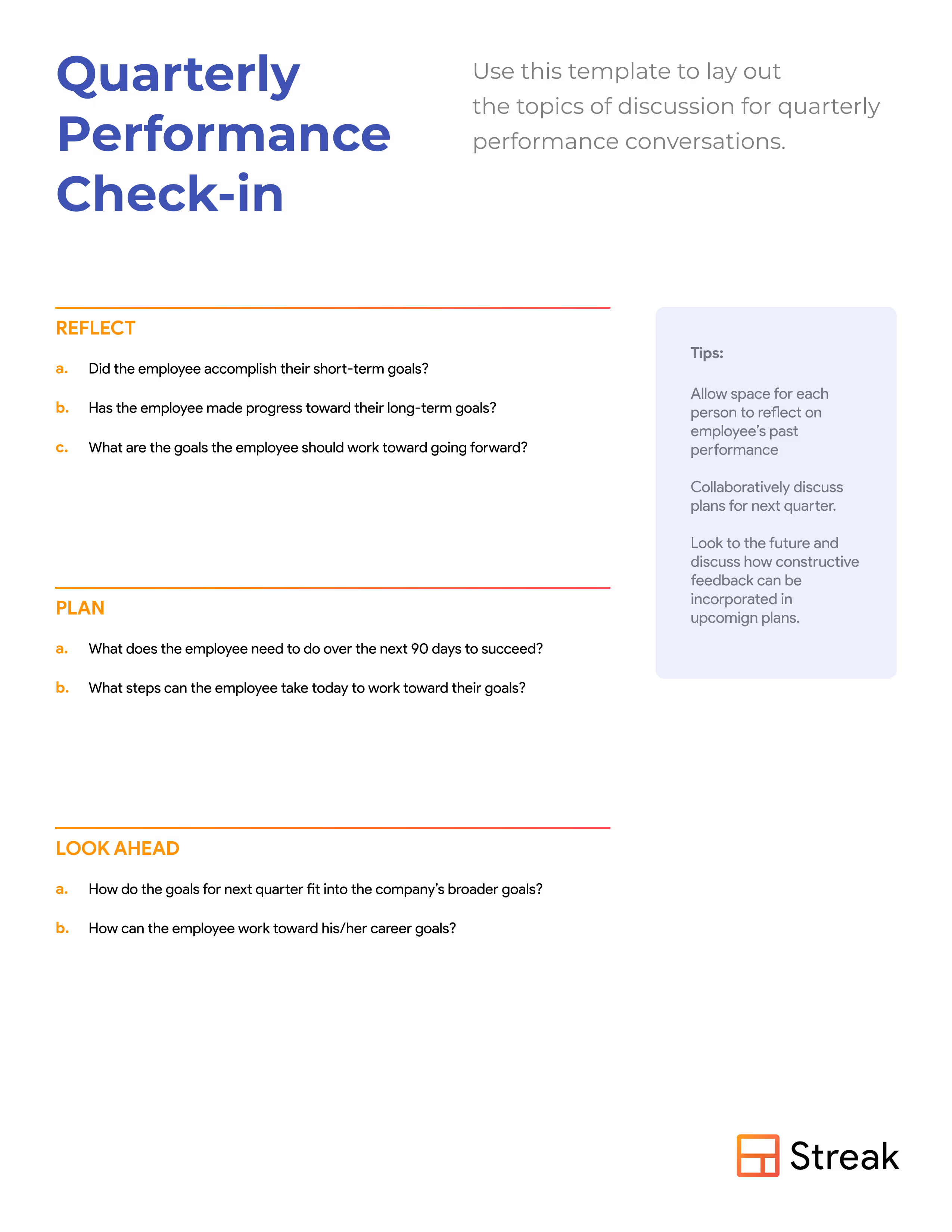
<div class="anchor-wrapper"><div id="360-performance-review" class="anchor-target"></div></div>
A 360 performance review template offers a perspective into the employee’s performance from every angle with feedback from their manager, coworkers, themselves, customers, and other employees when applicable.
With the help of a great performance review template, your employee performance reviews can be more effective than ever. Choose one of the above templates and modify it as needed depending on your company’s needs.
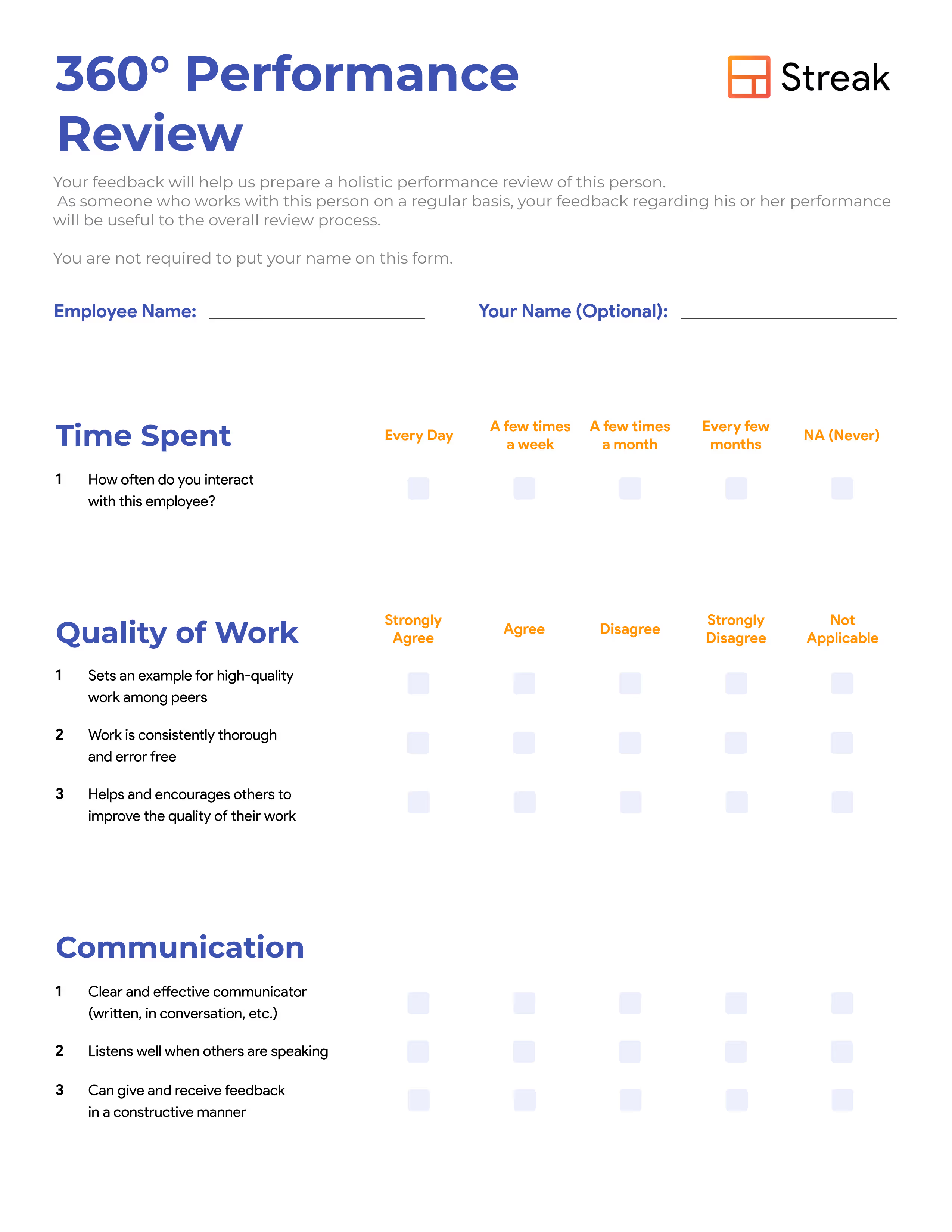
..avif)
Performance reviews are vital for any business seeking to thrive in today's competitive landscape. They empower employees to grow, align goals, and foster a culture of continuous improvement. By harnessing the insights gained from these assessments, businesses can optimize productivity, enhance teamwork, and ultimately achieve long-term success.
With the help of a great performance review template, your employee performance reviews can be more effective than ever. Choose one of the above templates and modify it as needed depending on your company’s needs.
